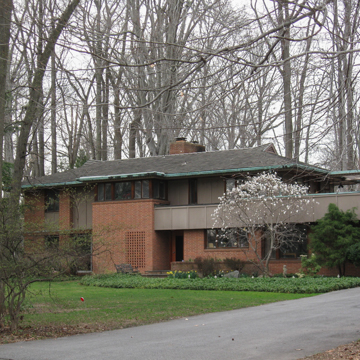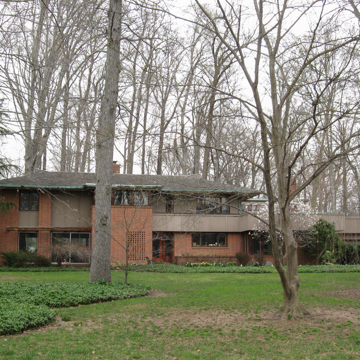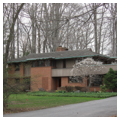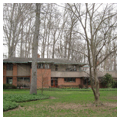Tafel served as Frank Lloyd Wright's apprentice in 1932–1941 and later practiced on his own in New York City, designing more than ninety houses nationwide, including this one for a client in the construction trades. The stamp of Wright (see Laurel, BR17) is immediately apparent in the horizontal format, long Roman bricks, wide eaves, and second-floor pergola that sweeps out to embrace a chimney. Top-quality materials were employed, including travertine marble for downstairs floors and cork upstairs, copper gutters, and a Ludowici clay tile roof that kicks up at the end, Japanese-style. Occupied by the original owners for half a century, the house today is well-preserved. Its new owners are architecture enthusiasts who have spoken with Tafel about this project and his memories of Wright. The surrounding Forest Hills Park neighborhood boasts an unusual concentration (for Delaware) of modernist houses of the 1950s to 1970s. At 4614 Bedford is another somewhat Wrightian dwelling, low and blending with the forested lot, designed by its owner (1958, Walter Scott Woods). The house at 4615, by Victorine and Samuel Homsey, has twelve rooms on its single, rambling floor. In contrast, the classical-style Dr. Park W. Huntington Jr. house nearby at 1701 Gunning Drive incorporated a room from a seventeenth-century Connecticut saltbox house.
You are here
Isaac Budovitch House
If SAH Archipedia has been useful to you, please consider supporting it.
SAH Archipedia tells the story of the United States through its buildings, landscapes, and cities. This freely available resource empowers the public with authoritative knowledge that deepens their understanding and appreciation of the built environment. But the Society of Architectural Historians, which created SAH Archipedia with University of Virginia Press, needs your support to maintain the high-caliber research, writing, photography, cartography, editing, design, and programming that make SAH Archipedia a trusted online resource available to all who value the history of place, heritage tourism, and learning.





